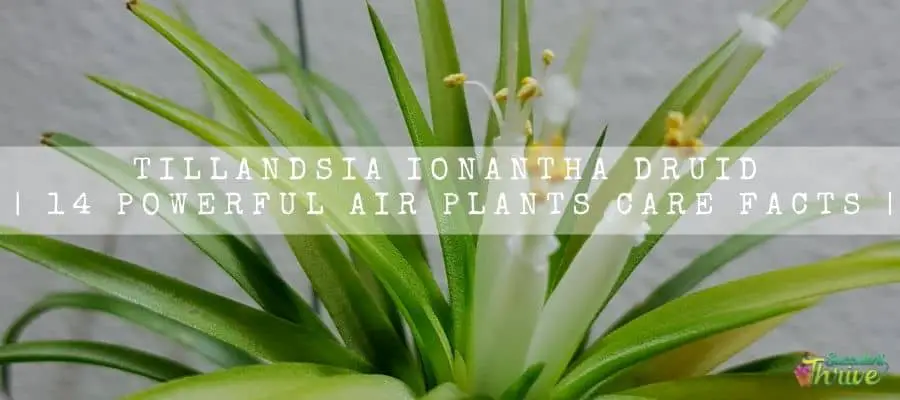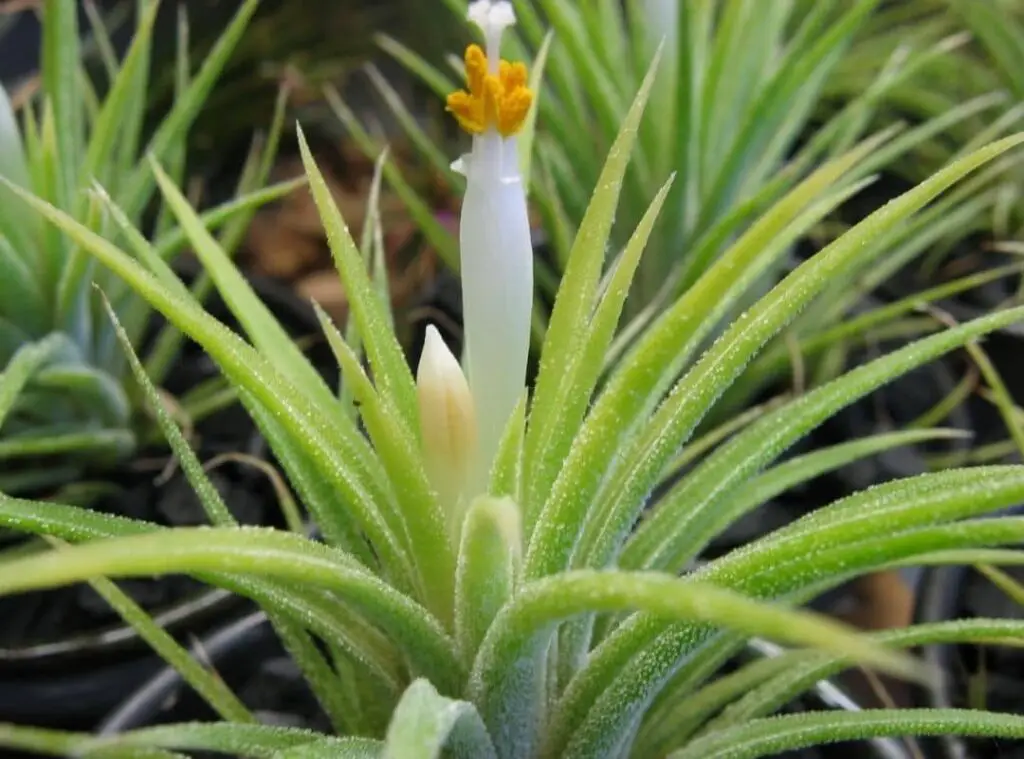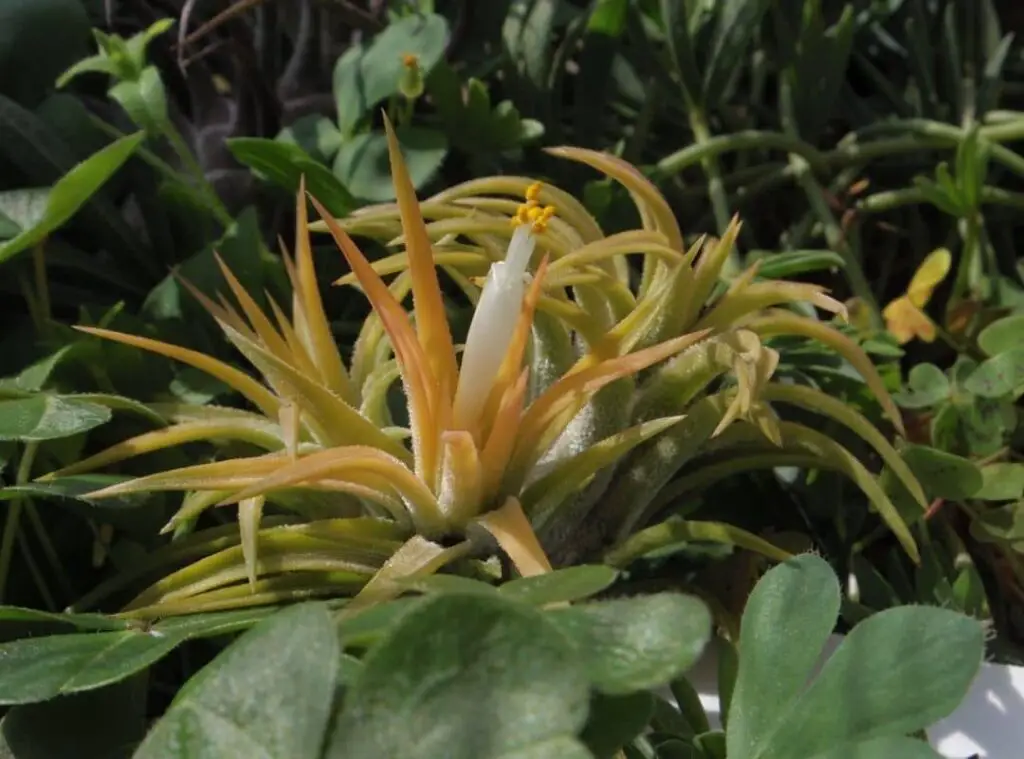Tillandsia ionantha druid is one attractive plant you will find in the entire cactus and succulents world. Tillandsia ionantha belong to the genus Tillandsia.
They are evergreen, perennial and rosette forming plants. You could commonly call them air plants.
In this article we are going to discuss about basic care facts on Tillandsia ionantha druids.

What is tillandsia ionantha druid?
They usually tend to grow as epiphytes and do not require soil to grow. They are also known as sky plant, blush bride, ionantha druid.
Tillandsia ionantha druids could simply attach to other plants and grow well. They consist of thicker leaves and that means they could withstand drought conditions well.
They are hardy plants and can thrive well with minimum supervision. In addition to that many people tend to grow them since you could easily propagate them as well.
You simply need to use their pups to do that. Once they start flowering, they would turn into yellow green, and you could spot their flowers in white.
Also the Tillandsia ionantha druid is in fact a cultivar or hybrid plant of Tillandsia ionantha
So, continue reading this article if you wish to learn on this plant more
How do I identify tillandsia ionantha druid?
Tillandsia ionantha could be identified by various characteristics of the plants.
First of all, they are small and evergreen plants. You could spot them in green and in golden yellow color when they are matured and ready to flower.
Further when they are immature, their leaves would be silvery green in color. When it comes to the sizes of the plats, they would be 2 inches in width as well as in height too.
Apart from that you could see how they are forming in a symmetrical leaf pattern as well. Due to this factor these would be a perfect fit for terrariums.
Apart from these features, their flowering activity would also be beneficial in identifying the Tillandsia ionantha druid plants.
In fact, Tillandsia ionantha druid plants produce white flowers, and they would tend to take a tubular shape.
Size of the plant
Tillandsia ionantha druid plants could grow up to a maximum height of 2 inches and their maximum width would also be 2 inches.
Growth
Tillandsia ionantha druid plants grow as solitary plants and chances are that they could grow in clumps as well. They are fast growing plants.
One look care guide
| Botanical Name | Tillandsia ionantha druid plants |
| Common Name | Sky plant blush bride Air plant |
| Plant Type | Air plant |
| Mature Size | 2 inches in width2 inches in height |
| Sun Exposure | Indirect bright sunlight |
| Soil Type | No soil need |
| Soil pH | No soil need |
| Bloom Time | Spring |
| Flower Color | White |
| Hardiness Zones | USDA hardiness zones 9b-11b. |
| Native Area | Central and south America |
| Toxicity | Nontoxic |
| Average price | $ 10 |
How do you take care of a tillandsia ionantha druid?
Light Requirement
Tillandsia ionantha druid plants prefer to grow in bright indirect sunlight. As such you could grow them well indoors.
Keep in mind to not to expose them to direct sunlight as it could create sunburns in the plants.
As such when you grow them indoors, do not leave them right at the windowsill where they will be exposed to direct sunlight as it could be harmful.
Instead grow Tillandsia ionantha druid plants a little far from the windows. Additionally, if you think they are lacking adequate sunlight, you could grow them near artificial lights.
A florescent light would be quite handy here.
Temperature and humidity
Tillandsia ionantha druid plants are fond of growing in temperatures around 50 degrees Fahrenheit – 80 degrees Fahrenheit.
Apart from that ensure that there is a good air circulation around the plants as well.

Is it cold hardy?
Tillandsia ionantha druid plants do not handle colds well.
USDA Hardiness Zone
Tillandsia ionantha druid are hardy in USDA hardiness zones 9b-11b.
Watering Requirement
Tillandsia ionantha druid plants could thrive well with minimum watering. Alternatively, you could consider misting them occasionally too.
In fact, you could consider misting them particularly if you have grown them in a well-ventilated area.
Avoid keeping the plants in wet conditions. Instead, you need to allow the plants to dry between two waterings and during the misting sessions.
Further ensure that no excess moisture is collected in the leaf axils as it will cause the plant to rot.
Ideally you could soak the plant in a water bowl once a week and you could do that for about 10 minutes time.
When you do that, ensure that the premature flowers are not submerged unless it would kill the premature blooms .
Apart from that as aforesaid you could mist them also. To do that you could use a spray water bottle and use it 3-4 times weekly.
Tillandsia ionantha druid plants are different to other succulents and cacti in general since they absorb water from their leaves and not from the roots.
You need to gently remove if there are any water pools remaining on the leaves unless it would lead to rot of the plants.
I recommend placing your plants in a dry place once you complete watering as it will allow the plants to wither.
Having said that, refrain in placing Tillandsia ionantha druid plants near intense heated places and ac units as well.
Once you water them with sufficient levels, it would help the plant leaves to become more vibrant in their silvery color.
Tillandsia ionantha druid plants are quite responsive to chemicals in water.
As such if you are using tap water to water them, ensure that you leave them in the water spray bottle for 24 hours so that the chemicals could evaporate.
Bottled water or rainwater would be perfect if you could use them to water them.
Soil Requirement Type / pH
They do not need soil to grow.
You might need pebbles, sand or rock as substrate. You can also grow them without any of the above medium.
As the name implies, these plants can grow in air.
Flowering and Fragrance
Tillandsia ionantha druid plants could produce flowers in white and they would be tubular shaped.
You could spot them flowering in spring. Those flowers have a smooth thin flower texture.
Pot size Potting and Repotting
They do not need traditional clay or terracotta pots. You can be creative here.
For example you can use a dried tree branch with hole or sea urchin shell to plant this air plant.
Where to Plant
A place where they can gain both bright and indirect sunlight would be ideal to grow these plants.
That is quite vital when selecting a spot to grow them. You could ideally plant them in a cute looking container and place them on your balcony.
Fertilizer and time of year
Tillandsia ionantha druid plants can thrive well with minimum fertilizers.
In fact, you have to use a diluted liquid fertilizer and apply them once every fortnight to their leaves .
Once you feed them the growth of the plants would be benefitted.
Air plants in general are quite different to other plants as they do not absorb fertilizers from their roots like the terrestrial plants.
I recommend using a urea free fertilizer which is a solution of 30-10-10.
Dormancy
Tillandsia ionantha druid plants’ dormancy period will be the winter. so that they can survive in winter and grow well once they reach their actively growing season.
Can be toxic to pets
Tillandsia ionantha druid plants are nontoxic plants for pets as well as for humans.

Common bugs and illnesses
Tillandsia ionantha druid plants are generally resistant towards pests’ attacks.
Further it is very unlikely that insects and pests invade them. The reason for them being resistant to pests’ attacks is that they do not grow in soil.
Tillandsia ionantha druid plants will grow healthily if they have a good ventilation around the plant.
Tillandsia ionantha druid plants would be handy to grow in wood or even in any other organic material.
Further you may grow them on top of stones or on sand as well. However, ensure that there are no water pools remaining in the plants as it will lead to rot.
Special Care tips
- It is very unlikely that you need to prune the plants. However, I recommend grooming them occasionally as it would help the plants to keep their unique shape in the foliage.
- Further it would be better if you could remove all the dead leaves and the flowers from the plants unless it would make the plant look unpleasant.
- You could sip off whatever the brown edges you spot in their leaves also. You may use sterile pair of scissors when pruning them
How to propagate tillandsia ionantha druid
Best way to propagate the Tillandsia ionantha druid plants is using their pups, seed or division.
Pups would usually arise at the base of the mother plant. Once the plant completes blooming you could spot about two to three pups forming at the plant base.
You could simply separate them when they are about 2/3 size of the mother plant and grow them as individual plants.
If you want to go for seed propagation, collect the seed produced by the plant once after the flowers dried. Let them dry well.
After one month, soak the seed and once you see the sprout leave them to produce leaves. Then you can place them anywhere you want.
Tillandsia ionantha druid plant benefits
- Tillandsia ionantha druid plants are handy as ornamental plants and as terrarium plants too.
- They would be useful as small garden plants as well as balcony plants too.
- Not only that but also, Tillandsia ionantha druid plants would be great picks for indoor gardens.
Conclusion
Before wrapping this up, trust now you were able to educate yourself on handling these beauties well and how to properly take care of them too.
Tillandsia ionantha druid plants could thrive well if you manage to supply them with bright and indirect sunlight.
They are resistant to diseases and they could thrive well on their own too. . So, hurry up, grab your Tillandsia ionantha druid plants and start growing them!
Read Next :Ferocactus Pilosus | 14 Rock Solid Care Facts For You |
